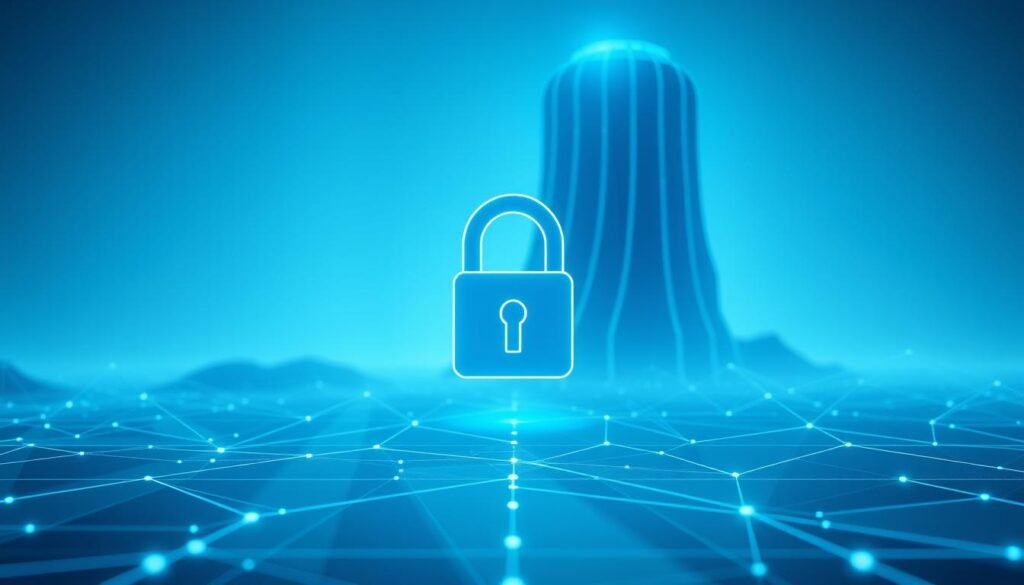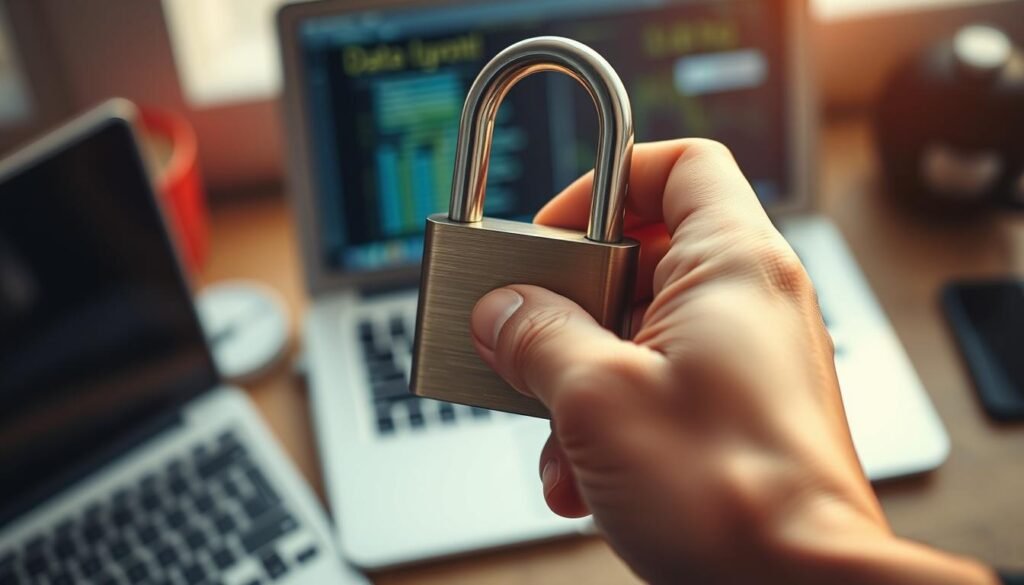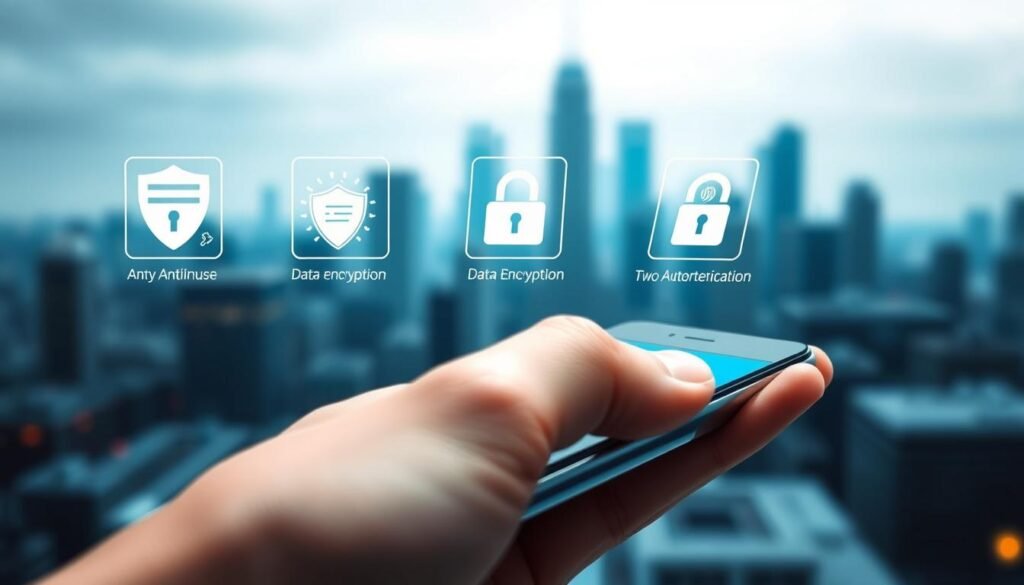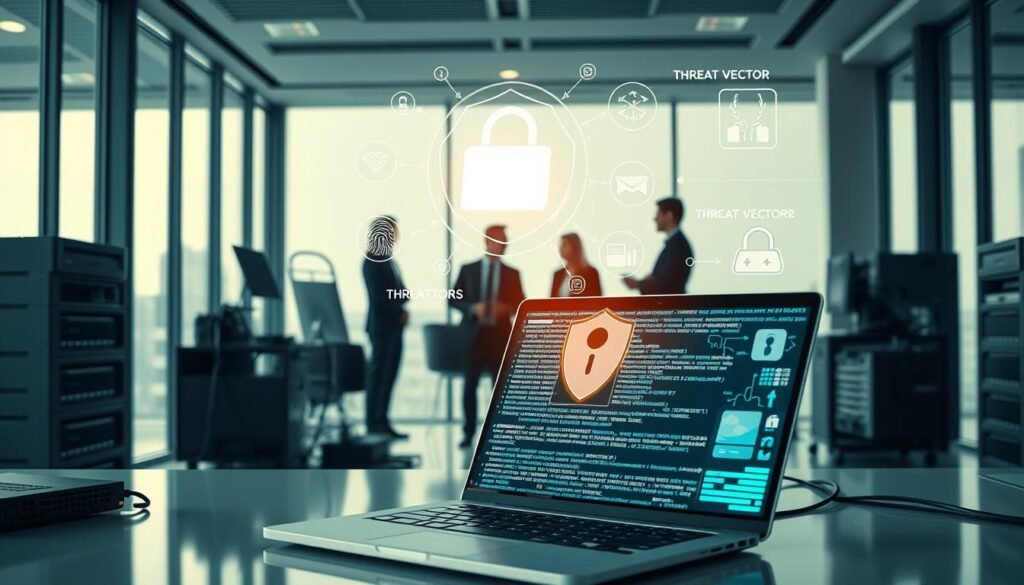Did you know that cybercrime is projected to cost the world $10.5 trillion annually by 2025? This staggering statistic underscores the critical need for reliable guides to navigate the complexities of digital safety and security.
In today’s digital landscape, having access to trustworthy information on how to protect personal data and maintain secure online behavior is crucial. As technology advances, so do the threats to our digital security, making it essential to stay informed about best practices for online safety.
Key Takeaways
- Understanding the importance of digital safety and security
- Learning best practices for protecting personal data
- Maintaining secure online behavior
- Staying informed about the latest cyber threats
- Navigating the online world with confidence
Understanding Digital Safety: Why It Matters
As we navigate the complexities of the digital landscape, grasping the concept of digital safety is vital. The rapid evolution of technology has brought numerous benefits, but it has also introduced significant risks. Understanding digital safety is crucial for protecting ourselves, our personal data, and our online identities.
The Growing Importance of Online Security
The importance of online security has grown exponentially with the rise of digital technologies. Cyberattacks are becoming more sophisticated, and the consequences of digital insecurity can be severe. According to the FBI’s Internet Crime Complaint Center (IC3), between 2019 and 2023, there were 3.79 million cyberattack complaints recorded, resulting in a total loss of $37.4 billion. This staggering figure highlights the growing importance of online security measures and the need for individuals and organizations to prioritize digital safety.
Implementing effective internet security measures is no longer optional but a necessity. This includes adopting robust online safety tips, such as using strong passwords, being cautious with emails and links, and keeping software up to date.
Consequences of Digital Insecurity
The consequences of digital insecurity can be far-reaching and devastating. Financial loss is a significant risk, but it’s not the only one. Identity theft, compromised personal data, and reputational damage are also potential outcomes of inadequate digital security. For individuals, this can mean losing control over personal information and facing financial ruin. For businesses, it can result in significant financial losses, legal repercussions, and a loss of customer trust.
Key Terms in Digital Safety
To effectively navigate the digital world, it’s essential to understand key terms related to digital safety. Terms like “malware,” “phishing,” and “encryption” are fundamental to grasping the concepts of digital security. Familiarizing oneself with these terms is the first step towards implementing effective online safety tips and protecting against cyber threats.
By understanding the importance of digital safety and staying informed about the latest internet security measures, we can better protect ourselves and our digital assets. This knowledge empowers us to take proactive steps against cyber threats and ensures a safer online experience.
Essential Practices for Online Privacy
With the rise of cyber threats, adopting essential practices for online privacy is more important than ever. In this digital age, our personal and professional lives are increasingly online, making it crucial to safeguard our digital presence.
Creating Strong Passwords
One of the foundational elements of online privacy is creating strong, unique passwords. A strong password is one that is difficult for others to guess but easy for you to remember. It’s recommended to use a combination of uppercase and lowercase letters, numbers, and special characters. For instance, a password like “Giraffe#LemonTree88!” is much stronger than “password123.”
- Use a password manager to generate and store complex passwords.
- Avoid using the same password across multiple sites.
- Change your passwords regularly, especially for sensitive accounts.
Utilizing Two-Factor Authentication
Two-factor authentication (2FA) adds an extra layer of security to your online accounts. It requires not only a password but also a second form of verification, such as a code sent to your phone or a biometric scan. This makes it significantly harder for attackers to gain unauthorized access to your accounts.
Benefits of 2FA:
- Enhanced security against phishing and password attacks.
- Protection against unauthorized access even if your password is compromised.
- Peace of mind knowing your accounts are more secure.
Managing Privacy Settings on Social Media
Social media platforms are a treasure trove of personal data, making it essential to manage your privacy settings effectively. By controlling who can see your posts, profile information, and contact details, you can significantly enhance your online privacy.
“The way to get started is to quit talking and begin doing.” – Walt Disney
Regularly review and update your privacy settings on social media platforms to ensure you’re comfortable with who has access to your information.

By implementing these essential practices—creating strong passwords, utilizing two-factor authentication, and managing privacy settings on social media—you can significantly bolster your online privacy and security.
Safe Browsing Habits to Adopt
With cyber threats on the rise, adopting safe browsing habits is more critical than ever. Ensuring your safety online involves a combination of awareness, using the right tools, and practicing caution when navigating the internet.
Recognizing Phishing Scams
Phishing scams are a common threat where attackers disguise themselves as trustworthy entities to steal sensitive information. To avoid falling prey to such scams, it’s essential to be cautious with emails and messages that ask for personal details.
- Be wary of generic greetings; legitimate organizations usually address you by name.
- Check for spelling and grammar mistakes, as professional companies typically have polished communications.
- Avoid clicking on suspicious links or downloading attachments from unknown sources.
The Importance of URL Verification
Verifying the URL of a website is a simple yet effective way to ensure you’re on a legitimate site. Look for “https” at the beginning of the URL, which indicates a secure connection.
Tips for URL Verification:
- Check the domain name for any misspellings or unusual characters.
- Be cautious of sites with numerous pop-ups or unusual requests for information.
Browser Security Features
Modern web browsers come equipped with various security features designed to protect users. Understanding and utilizing these features can significantly enhance your online security.
Some key browser security features include:
- Pop-up blockers to prevent unwanted or malicious pop-ups.
- Private browsing modes that don’t save your browsing history.
- Warnings for potentially dangerous sites.
By adopting these safe browsing habits, you can significantly reduce your risk of encountering cyber threats. Staying informed and vigilant is key to a safer online experience.
Protecting Your Personal Data
Protecting personal data requires a multi-faceted approach that includes several key strategies. In today’s digital landscape, individuals must be proactive to safeguard their information from various threats.
Understanding Data Encryption
Data encryption is a critical component of data protection. It involves converting plaintext data into unreadable ciphertext to prevent unauthorized access. Encryption is essential both for data in transit (e.g., when sending emails or making online transactions) and for data at rest (e.g., data stored on devices or cloud storage). By encrypting data, individuals can ensure that even if their information is intercepted or accessed without authorization, it will be unintelligible to the perpetrator.
There are several encryption technologies available, including:
- SSL/TLS for securing web traffic
- AES for encrypting stored data
- PGP for secure email communication
Utilizing VPNs for Secure Connections
A Virtual Private Network (VPN) provides a secure, encrypted connection between a user’s device and a VPN server. This is particularly important when using public Wi-Fi networks, which are often unsecured and vulnerable to hacking. By using a VPN, individuals can protect their data from being intercepted by malicious actors on public networks.

Backing Up Your Data Effectively
Regular data backups are a crucial aspect of data protection. In the event of data loss due to hardware failure, software corruption, or cyberattack, having backups ensures that individuals can recover their information. It’s recommended to follow the 3-2-1 backup rule: three copies of data, on two different types of media, with one copy stored offsite.
- Use external hard drives for local backups
- Utilize cloud storage services for offsite backups
- Regularly test backup restorations to ensure data integrity
By understanding and implementing these data protection strategies, individuals can significantly enhance the security of their personal data. Whether through encryption, VPNs, or regular backups, taking proactive steps is key to protecting against the ever-evolving landscape of cyber threats.
Cybersecurity Tools You Should Consider
To stay safe online, it’s vital to understand and utilize key cybersecurity tools designed to protect your digital presence. In today’s digital age, having the right tools is not just a precaution; it’s a necessity for safeguarding your personal and professional data.
Antivirus Software Essentials
Antivirus software is a fundamental tool in your cybersecurity arsenal. It helps detect, prevent, and remove malware from your devices. When choosing antivirus software, look for features such as real-time scanning, automatic updates, and comprehensive threat detection.
Key Features to Consider:
- Real-time protection against viruses and malware
- Automatic updates to stay ahead of new threats
- Scanning of emails and downloaded files
Firewalls: Your First Line of Defense
A firewall acts as a barrier between your computer and the internet, controlling incoming and outgoing network traffic based on predetermined security rules. It helps block unauthorized access to your computer, protecting your data from hackers.
Configuring Your Firewall: Ensure that your firewall is enabled and properly configured to allow legitimate communications while blocking malicious traffic.
Password Managers Explained
Password managers are tools that securely store and manage your passwords. They help generate complex, unique passwords for each of your accounts, reducing the risk of using weak or repeated passwords.
Benefits of Using a Password Manager:
- Generation of complex, unique passwords
- Secure storage of passwords, protected by a master password
- Auto-fill capabilities for easy login
By incorporating these cybersecurity tools into your digital safety practices, you can significantly enhance your online security and protect your digital identity.
Staying Safe on Mobile Devices
As we rely more heavily on mobile devices, the importance of implementing effective internet security measures cannot be overstated. Mobile devices, like computers, are vulnerable to cyber threats, making it crucial to adopt cyber security best practices to protect them.
One of the simplest yet most effective ways to enhance mobile device security is by keeping the operating system (OS) and apps up to date. Updates often include patches for security vulnerabilities that have been discovered since the last update.
Updating Apps and Operating Systems
Regular updates are vital because they fix security flaws that could be exploited by hackers. Enabling automatic updates for your OS and apps ensures you receive these security patches as soon as they’re available, reducing the risk of your device being compromised.
Avoiding Public Wi-Fi Risks
Public Wi-Fi networks pose significant risks to mobile device users. These networks are often unsecured, making it easier for hackers to intercept data transmitted over them. To mitigate this risk, avoid accessing sensitive information when connected to public Wi-Fi, or use a Virtual Private Network (VPN) to encrypt your internet traffic.

Using Security Apps on Smartphones
In addition to keeping your OS and apps updated, using security apps can provide an additional layer of protection. These apps can detect and remove malware, protect against phishing attempts, and even help locate your device if it’s lost or stolen.
By following these cyber security best practices, you can significantly enhance the security of your mobile devices. Remember, staying safe in the digital world requires ongoing effort and awareness of the latest threats and protective measures.
The Role of Parents in Digital Safety
Parents play a crucial role in safeguarding their children’s online experiences. In today’s digital landscape, it’s essential for parents to be proactive in ensuring their children’s safety online.
Educating Children About Online Risks
One of the most effective ways parents can ensure their children’s digital safety is by educating them about online risks. This includes discussing the dangers of phishing scams, cyberbullying, and inappropriate content. By having open and honest conversations, parents can help their children develop safe browsing habits and a better understanding of how to navigate the online world.
It’s also important for parents to stay involved in their children’s online lives, monitoring their activity and providing guidance on how to avoid potential threats. This can involve setting clear rules and consequences for online behavior, as well as being a positive role model by practicing good digital citizenship themselves.
Setting Up Parental Controls
Setting up parental controls is another crucial step in ensuring digital safety. Parental controls can help limit access to inappropriate content, restrict online interactions with strangers, and monitor online activity. Parents can use software or apps designed for this purpose, configuring them to suit their child’s age and maturity level.
Many devices and platforms offer built-in parental control features. For example, parents can use these features to block certain websites, limit screen time, and track their child’s location. By utilizing these tools, parents can create a safer online environment for their children.
Monitoring Online Activity Responsibly
Monitoring online activity is a delicate balance between ensuring safety and respecting privacy. Parents should aim to be transparent about their monitoring practices, explaining to their children why it’s necessary and how it helps keep them safe. This can involve using monitoring software that tracks online activity, as well as regularly checking the devices their children use.
By being actively involved in their children’s online lives and following digital privacy guidelines, parents can help their children navigate the complexities of the digital world. This not only enhances their safety but also fosters a healthy and responsible approach to technology use.
Keeping Your Business Data Secure
The importance of keeping business data secure cannot be overstated in the current cyber threat landscape. As businesses increasingly rely on digital technology, the risk of cyberattacks grows, making robust data protection strategies essential for companies of all sizes.
Crafting a Comprehensive Cybersecurity Policy
A well-structured cybersecurity policy is the foundation of any effective data security strategy. This policy should outline the procedures and guidelines for protecting business data, including:
- Data encryption methods
- Access controls and user authentication
- Incident response plans
- Employee roles and responsibilities in data security
By having a clear and comprehensive cybersecurity policy, businesses can ensure that all employees understand their role in maintaining data security.

Employee Training: The Human Element of Cybersecurity
Employees are often the weakest link in a company’s cybersecurity chain. Providing regular training on cybersecurity best practices can significantly reduce the risk of human error leading to a data breach. Training should cover:
- Recognizing phishing attempts and other social engineering tactics
- Creating strong, unique passwords
- Safe internet browsing practices
- Reporting suspicious activities
By educating employees on these critical areas, businesses can enhance their overall security posture.
Conducting Regular Security Audits
Regular security audits are crucial for identifying vulnerabilities in a company’s data security infrastructure. These audits should:
- Assess the current state of cybersecurity measures
- Identify potential weaknesses and threats
- Recommend improvements and updates to security protocols
By conducting regular security audits, businesses can stay ahead of emerging threats and ensure their data protection strategies remain effective.
In conclusion, securing business data requires a multi-faceted approach that includes a robust cybersecurity policy, comprehensive employee training, and regular security audits. By implementing these measures, businesses can significantly enhance their secure online behavior and protect their valuable data assets.
Recognizing and Reporting Cybercrime
With the increasing reliance on digital technologies, the ability to recognize and report cybercrime has become more important than ever. Cybercrime can affect anyone, from individuals to large businesses, causing significant financial and reputational damage.
Signs of Being Hacked
Being aware of the signs that indicate you’ve been hacked is the first step in mitigating potential damage. Some common signs include:
- Unusual account activity, such as unfamiliar transactions or login locations.
- Suspicious emails or messages that ask for personal information or contain malicious links.
- Slow computer performance or frequent crashes, which could indicate malware infection.
Monitoring your digital footprint regularly can help you identify these signs early.
How to Report Cybercrime
If you suspect you’ve been a victim of cybercrime, it’s crucial to report it to the appropriate authorities. Here’s how:
- Contact your local law enforcement agency or cybercrime unit.
- Report the incident to the relevant online platforms or financial institutions involved.
- File a complaint with the Internet Crime Complaint Center (IC3) if you’re in the United States.
Keeping detailed records of the incident can aid in the investigation.
Resources for Victims of Cybercrime
Victims of cybercrime can access various resources for support and recovery. These include:
- Online resources and guides provided by cybersecurity organizations.
- Support groups for victims of cybercrime.
- Professional services, such as cybersecurity consultants, to help secure your digital presence.
By being proactive and informed, individuals and businesses can effectively respond to and recover from cybercrime incidents.
Staying Informed About Digital Threats
The ever-changing nature of cyber threats makes it vital to remain informed and proactive in your cybersecurity efforts. As technology advances, so do the tactics of cybercriminals, making it essential to stay abreast of the latest developments in digital security.
Cybersecurity News: Your First Line of Defense
Following reputable sources of cybersecurity news is a fundamental step in staying informed. Websites like Cybersecurity Ventures, Dark Reading, and Threatpost provide timely updates on emerging threats and best practices in cybersecurity. By staying current with the latest news, you can anticipate and prepare for potential threats before they become incidents.
The Power of Professional Networks
Joining professional networks related to cybersecurity can offer valuable insights and resources. These networks often include experts who share their experiences and knowledge, providing a wealth of information that can help you enhance your cybersecurity posture. Whether through online forums, social media groups, or industry conferences, being part of a professional network can be incredibly beneficial.
Learning Through Webinars and Workshops
Participating in webinars and workshops is an effective way to gain hands-on knowledge and stay updated on the latest cybersecurity trends. These educational events often feature industry experts who share their insights and provide practical advice on implementing effective cybersecurity measures. By attending these events, you can gain a deeper understanding of how to protect your digital assets.
In conclusion, staying informed about digital threats requires a multifaceted approach that includes following cybersecurity news, joining professional networks, and participating in educational events. By adopting these practices, you can significantly enhance your ability to protect against cyber threats.
The Future of Digital Safety: Trends to Watch
As technology continues to evolve, the landscape of digital safety is expected to change significantly. Staying informed about emerging trends is crucial for maintaining safe browsing habits and adhering to digital privacy guidelines.
Advances in Cybersecurity Technologies
Artificial intelligence and machine learning are poised to play a significant role in enhancing cybersecurity capabilities. These technologies can help detect and respond to threats more effectively, making digital environments more secure.
Emerging Challenges with IoT
The growing Internet of Things (IoT) introduces new security challenges. As more devices become connected, the potential attack surface expands, requiring innovative solutions to protect user data and maintain digital privacy.
Predictions for the Next Decade
Looking ahead, the next decade is expected to bring continued evolution in digital threats and defenses. By understanding these trends, individuals and organizations can prepare for the future of digital safety and stay ahead of emerging threats, ensuring safe browsing habits and compliance with digital privacy guidelines.
FAQ
What are the best practices for online privacy?
How can I protect my personal data from cyber threats?
What are some safe browsing habits I should adopt?
How can I stay safe on mobile devices?
What role do parents play in ensuring digital safety for their children?
How can businesses keep their data secure?
What are the signs of cybercrime, and how should I report it?
How can I stay informed about the latest digital threats?
What are the future trends in digital safety?
What cybersecurity tools should I consider for my digital security?
Prabir Dutta
Prabir Dutta is a passionate digital creator, affiliate marketer, and wellness enthusiast who simplifies complex topics like AI tools, Vastu, pet care, and modern living. With a keen eye for SEO, tech trends, and everyday health solutions, he writes to empower readers with actionable, smart-living insights. When not curating content across his network of niche blogs, Prabir enjoys exploring new digital tools that make life easier and more efficient.






